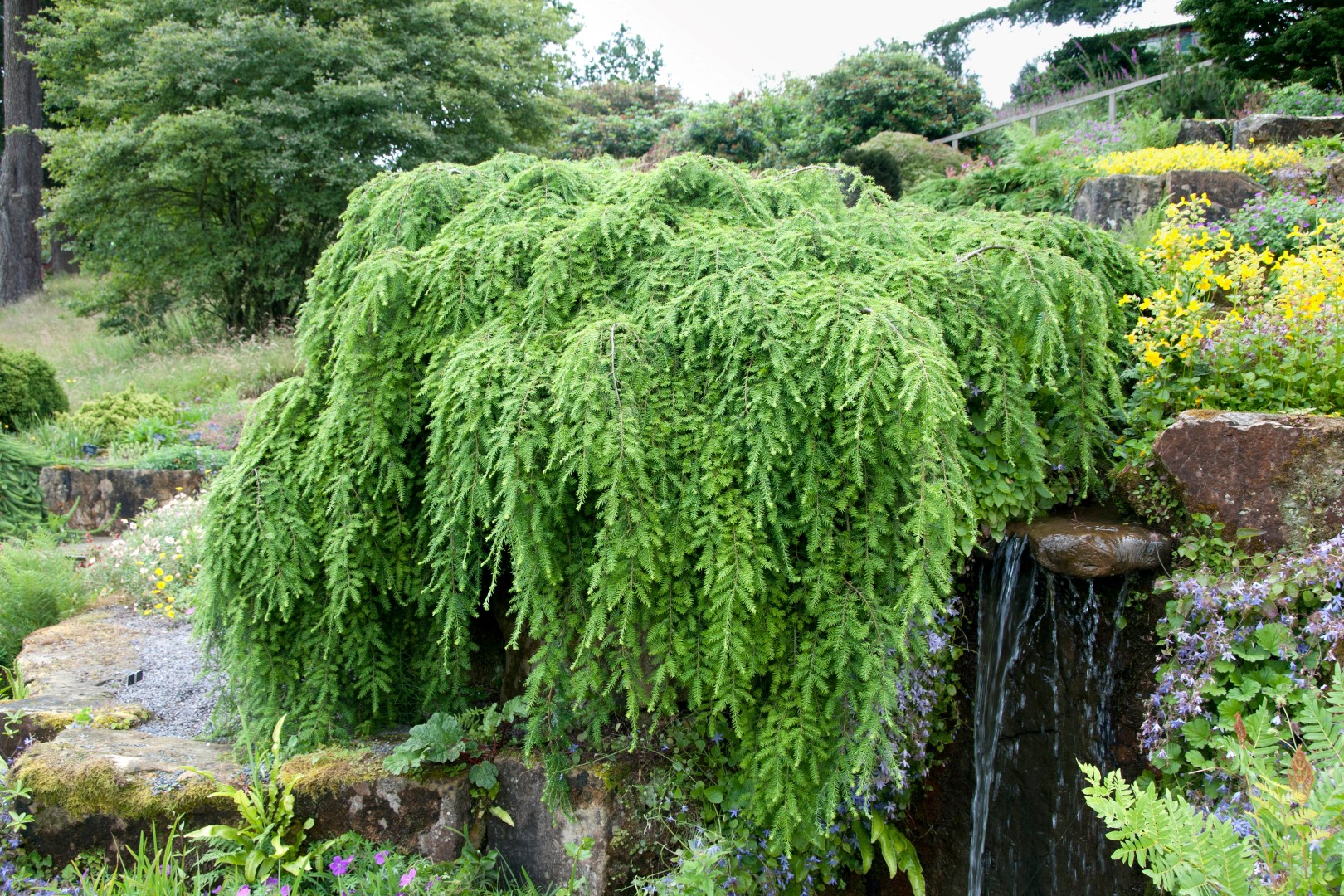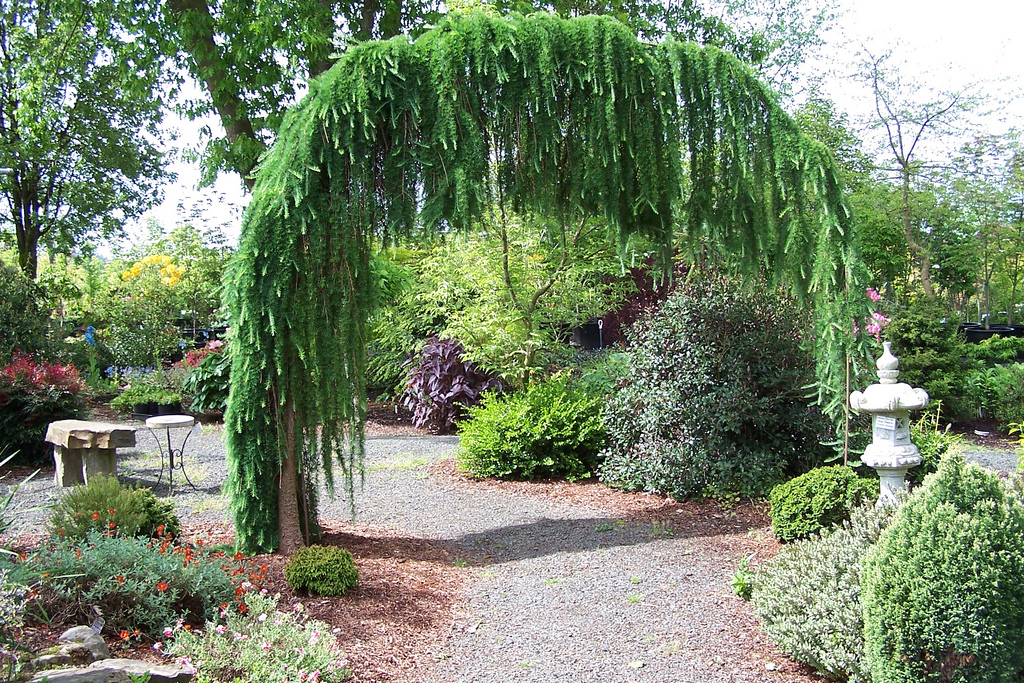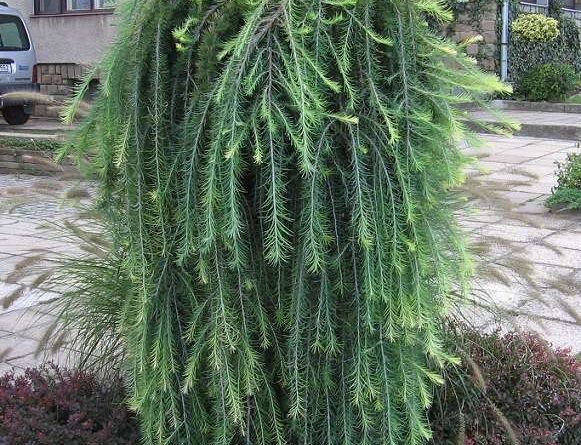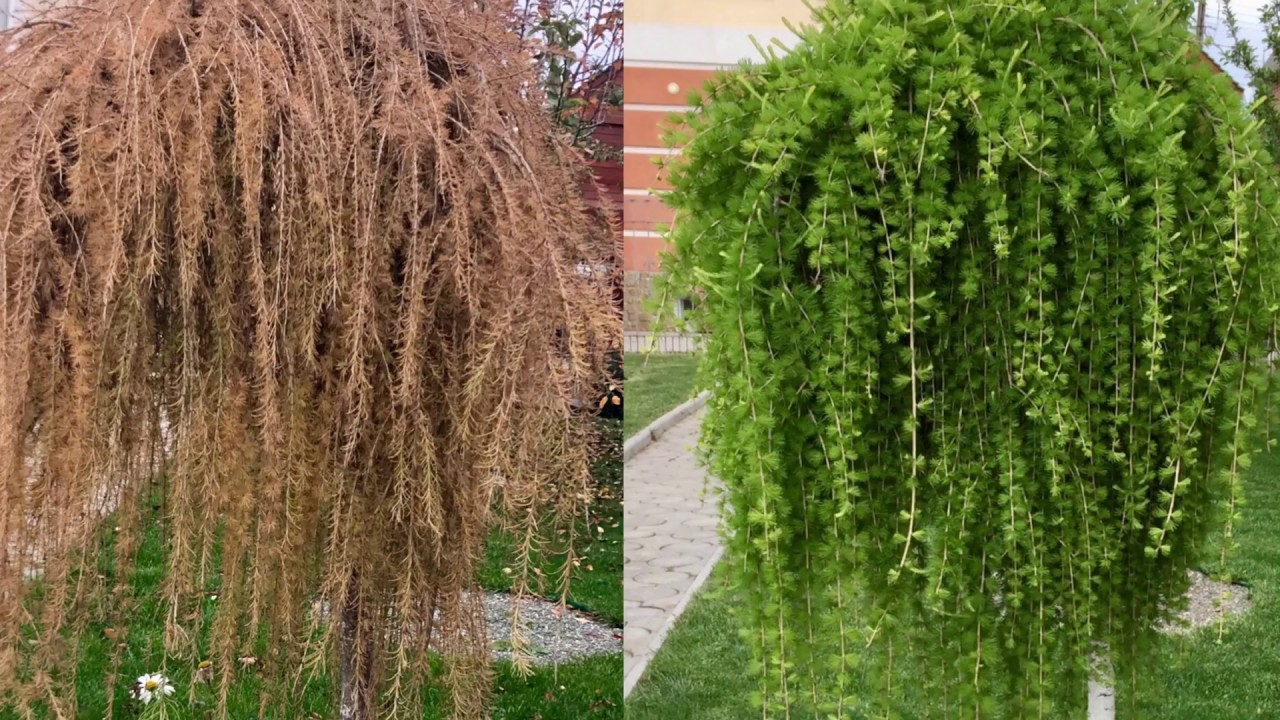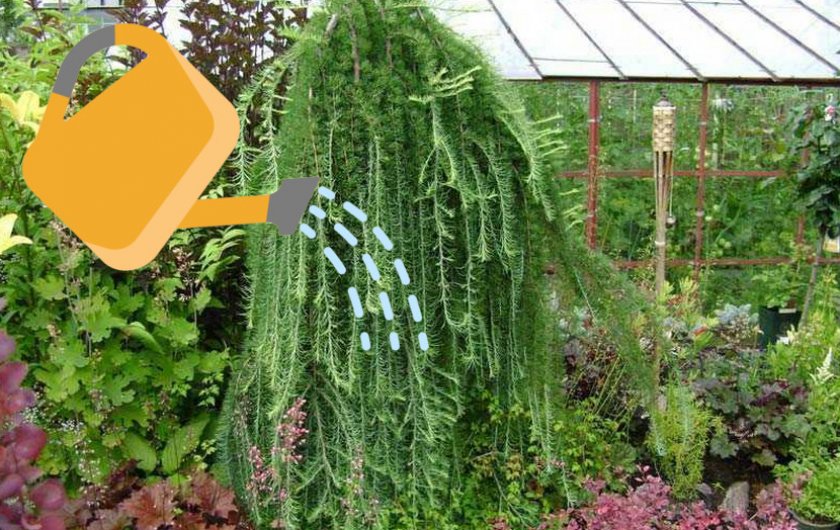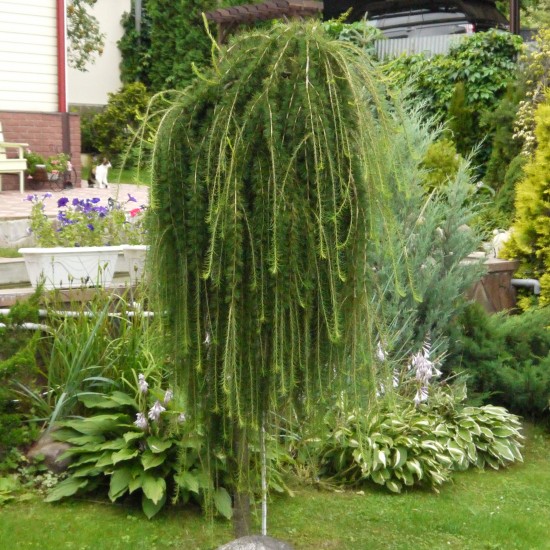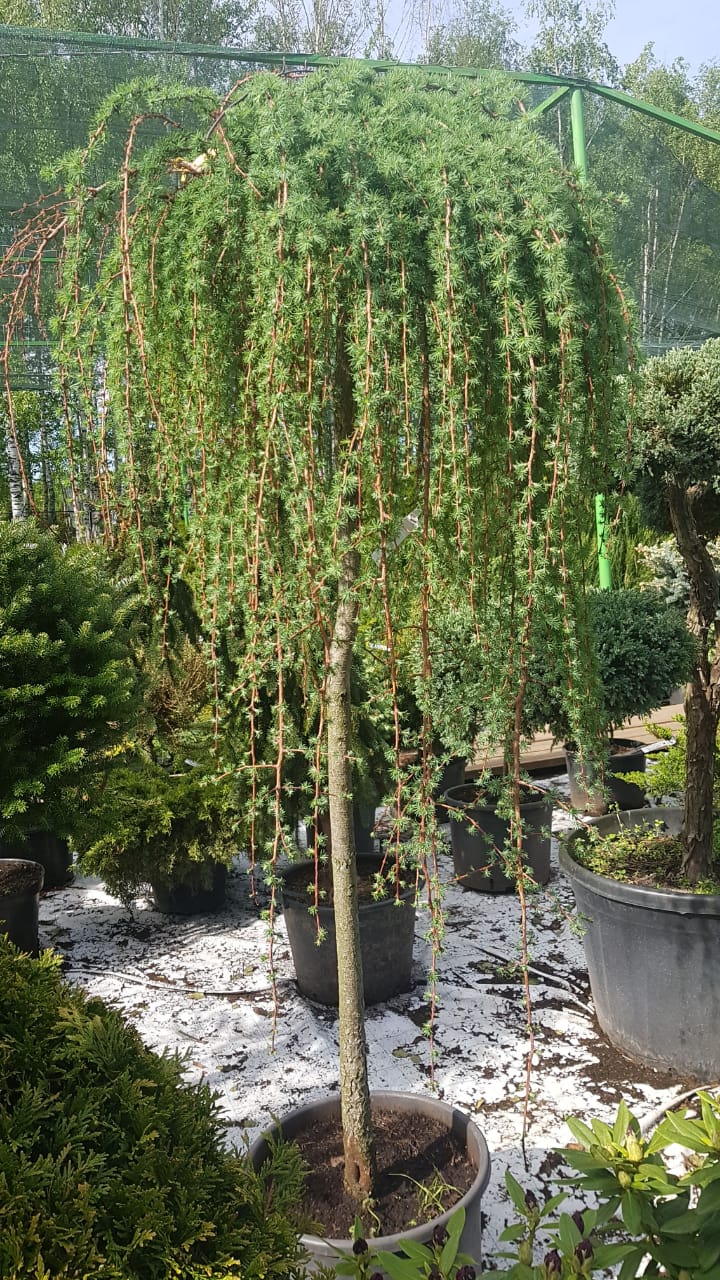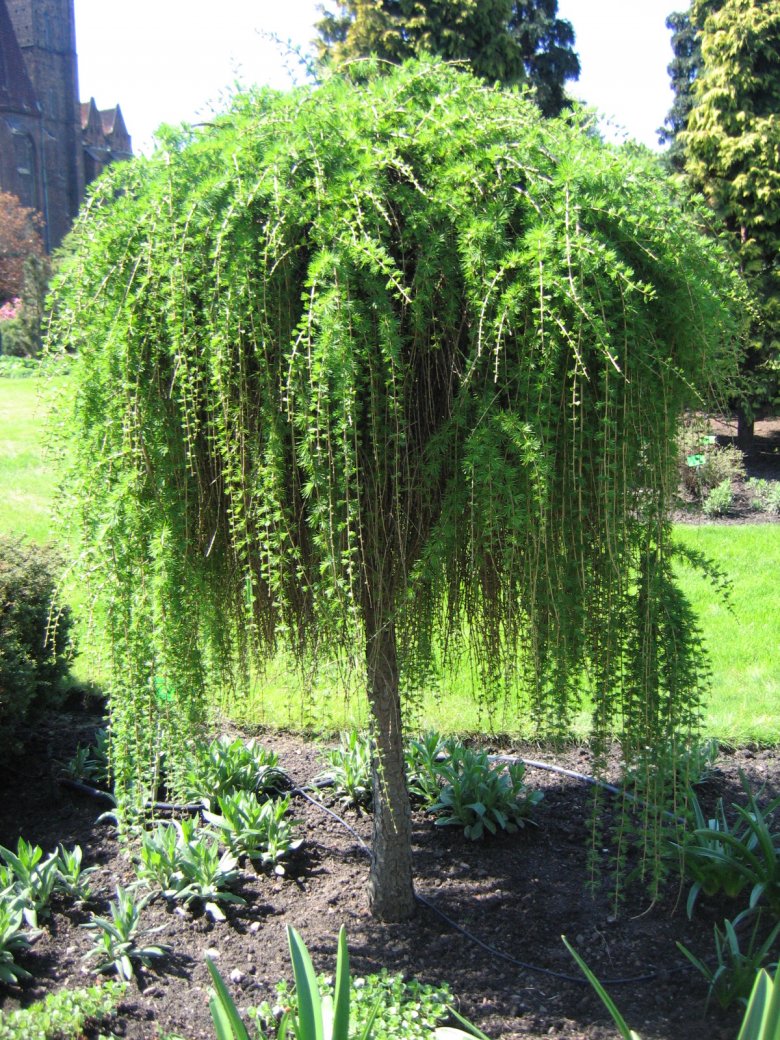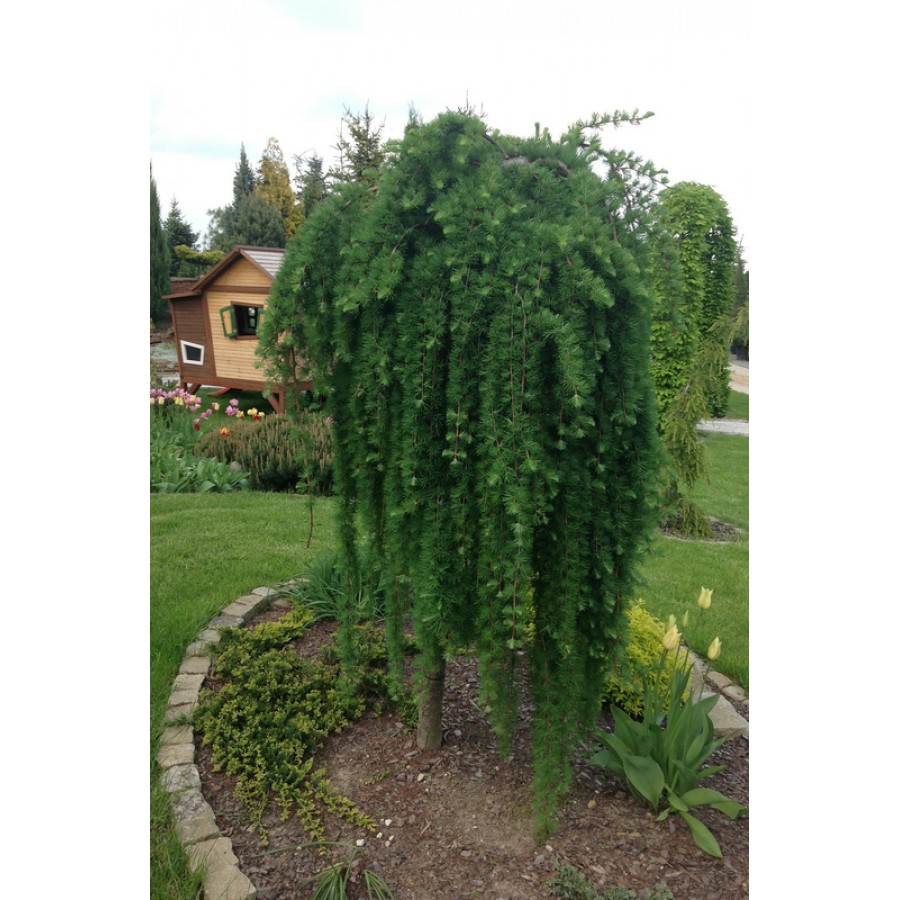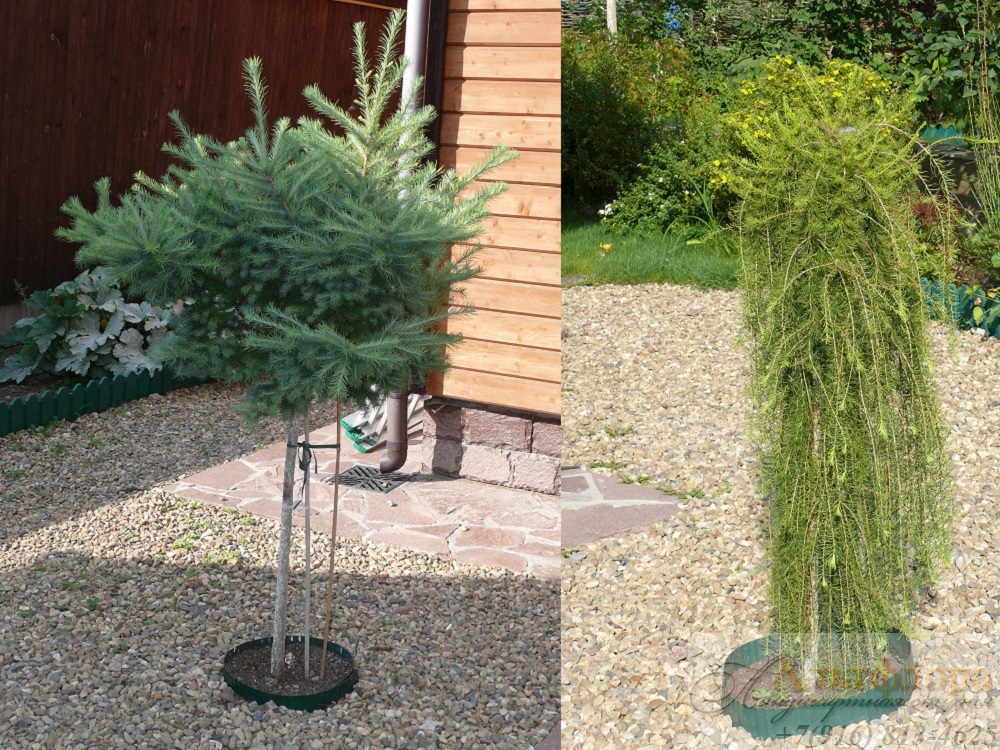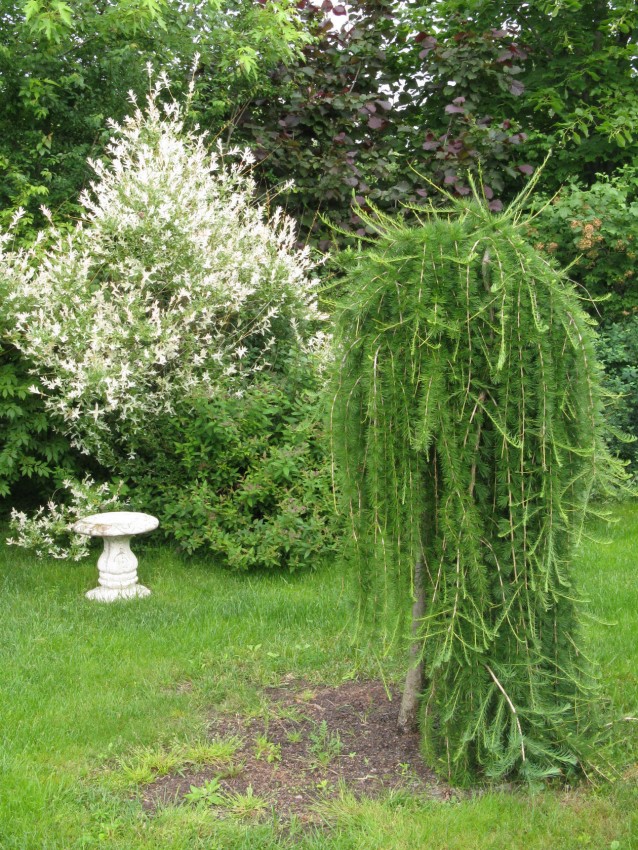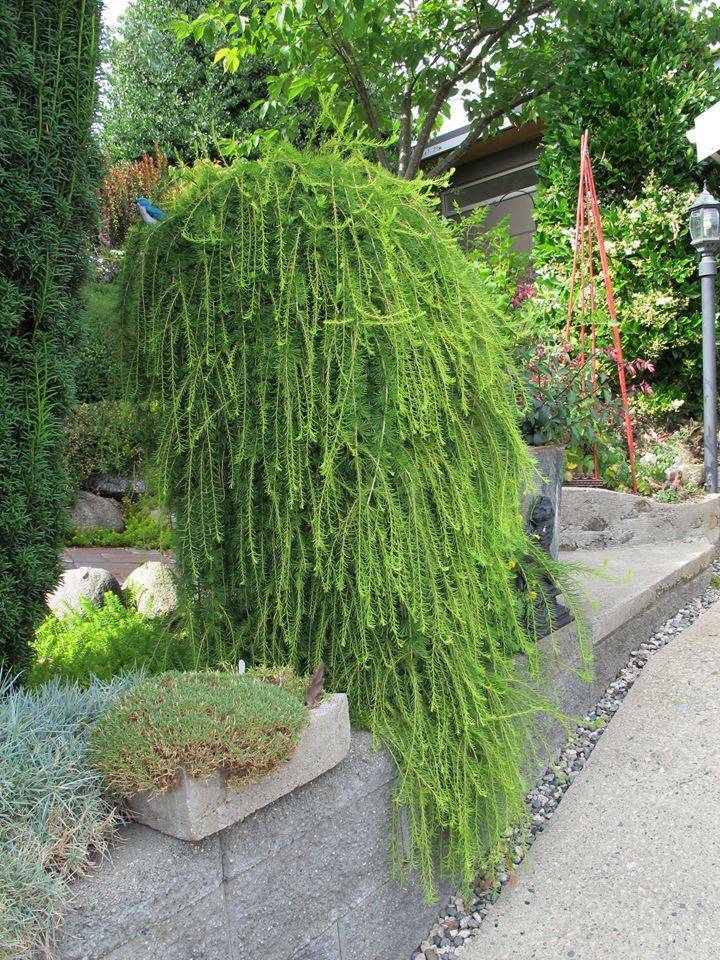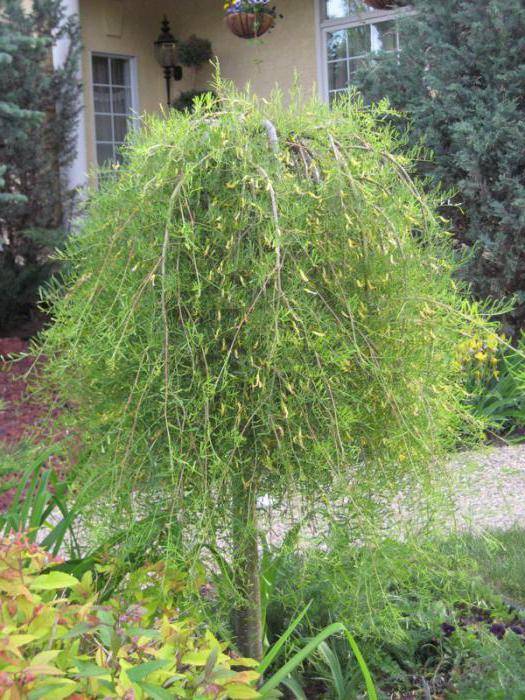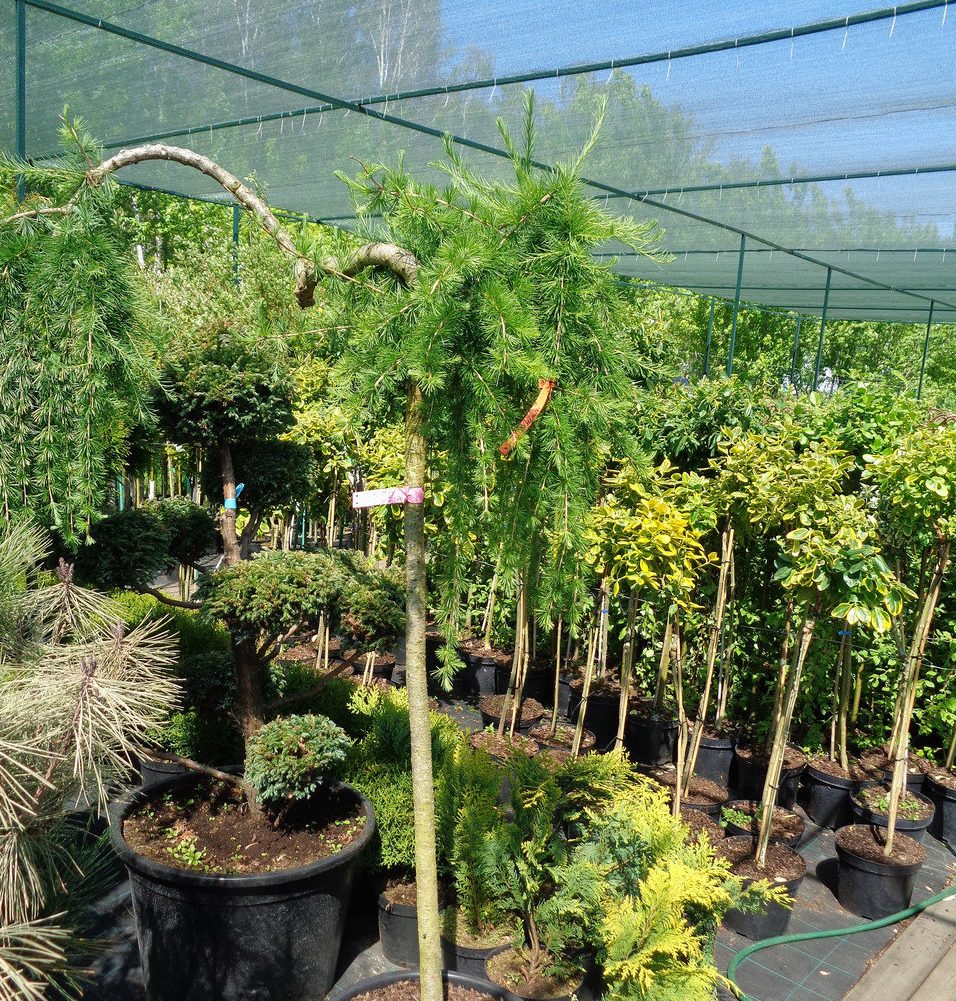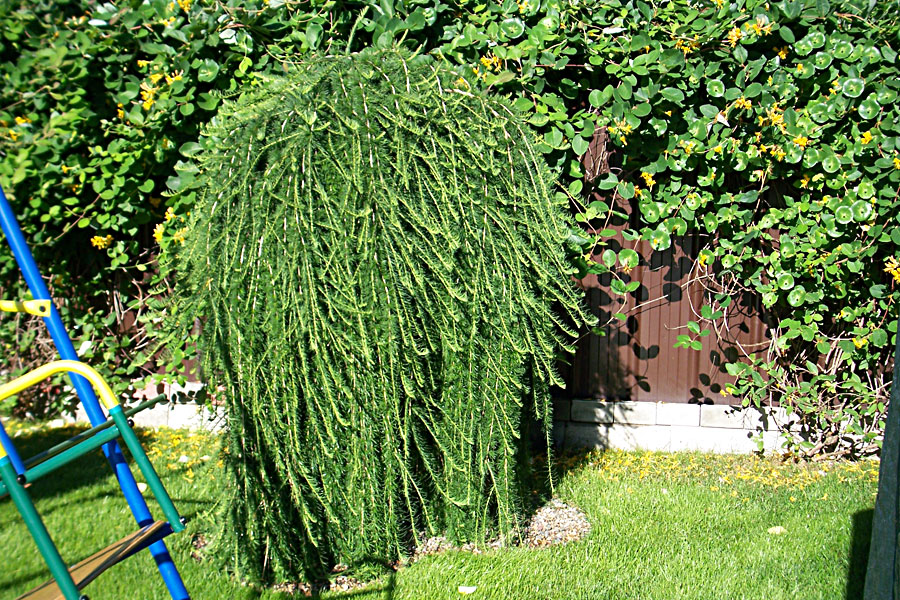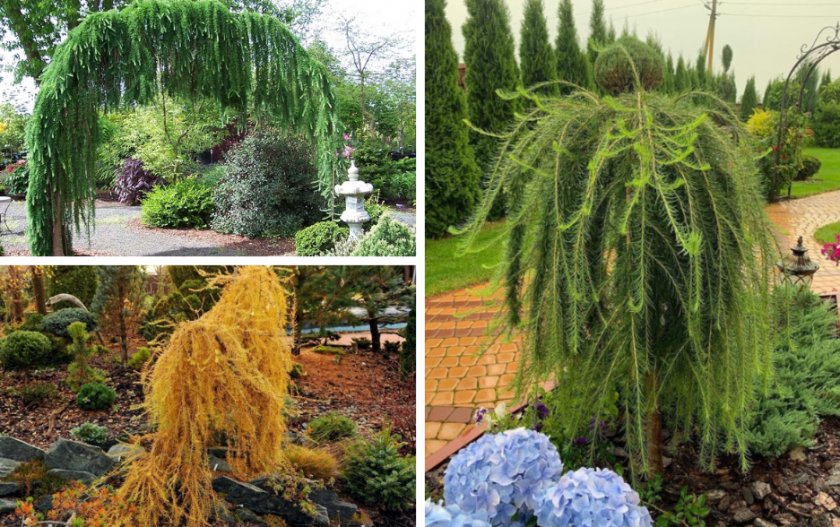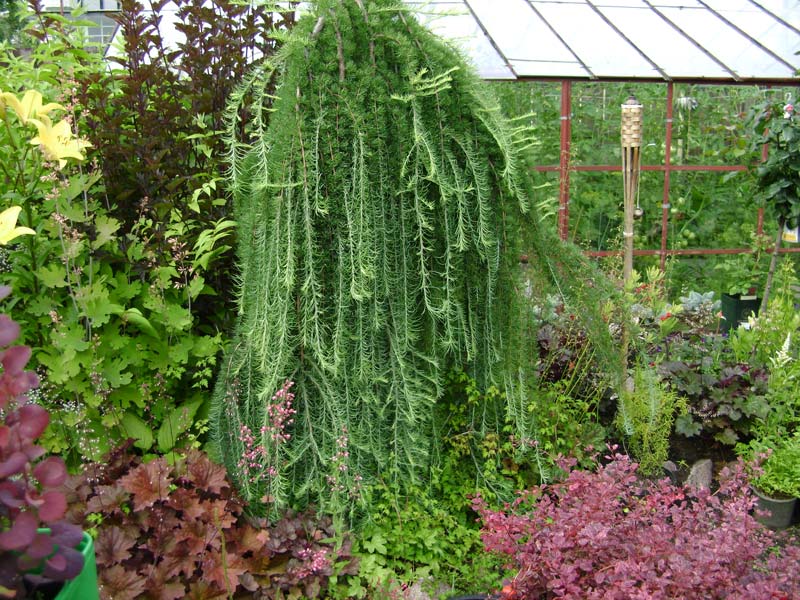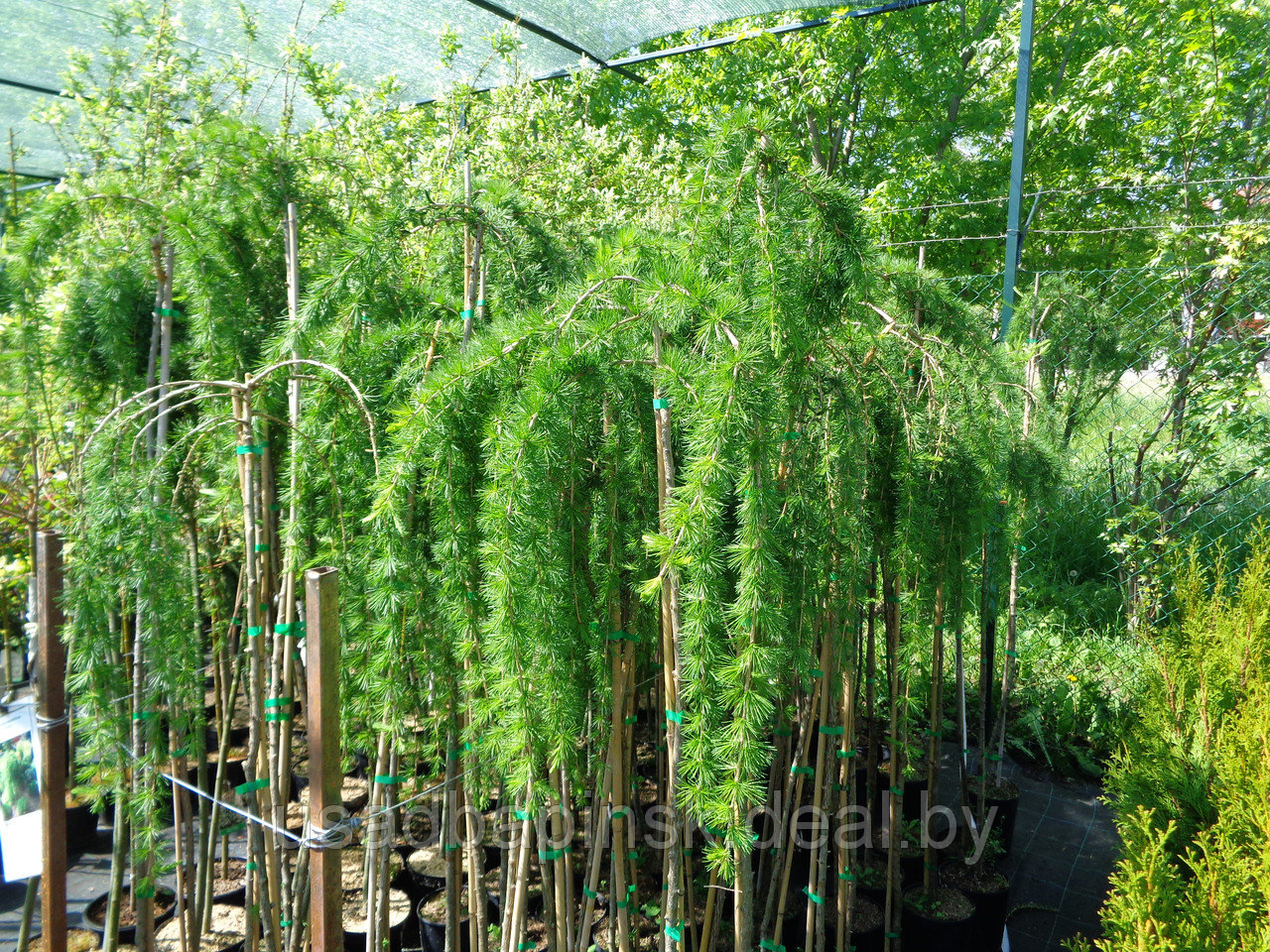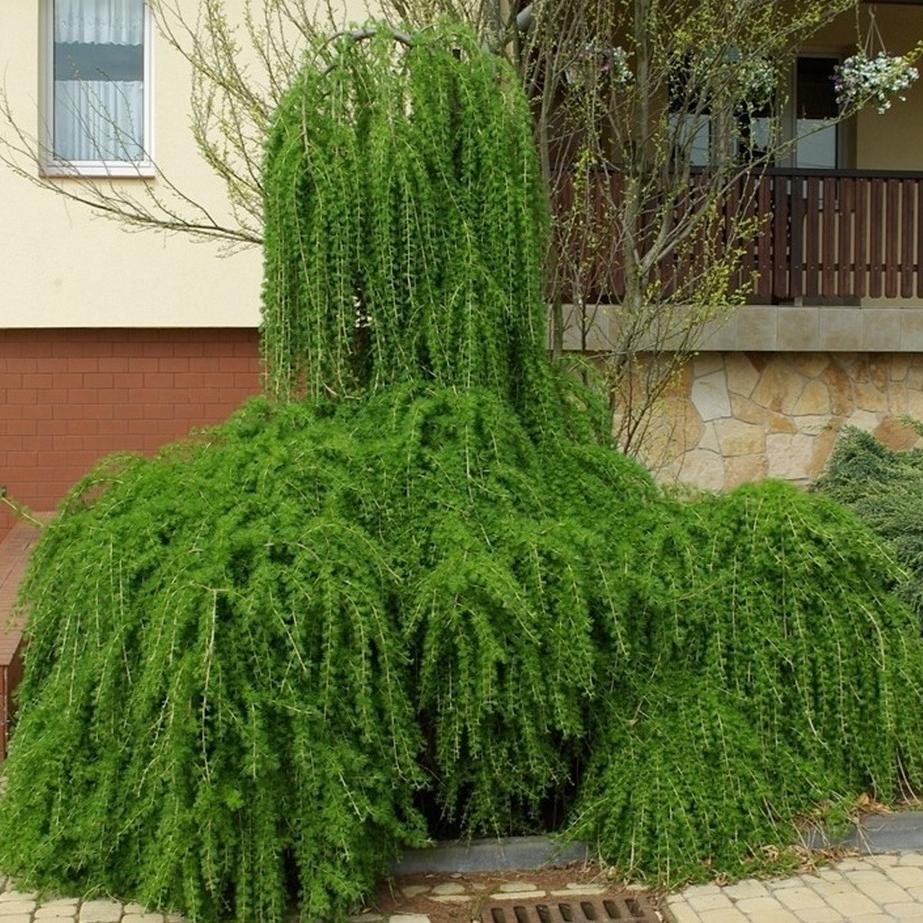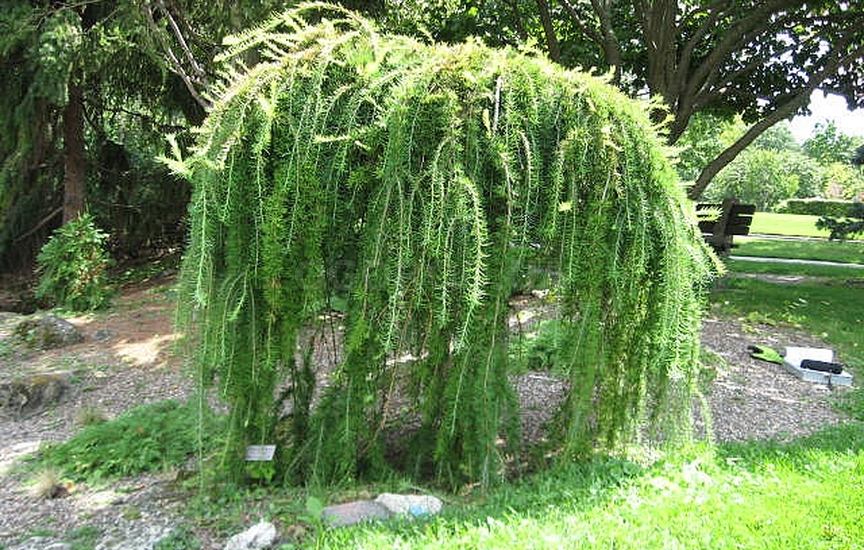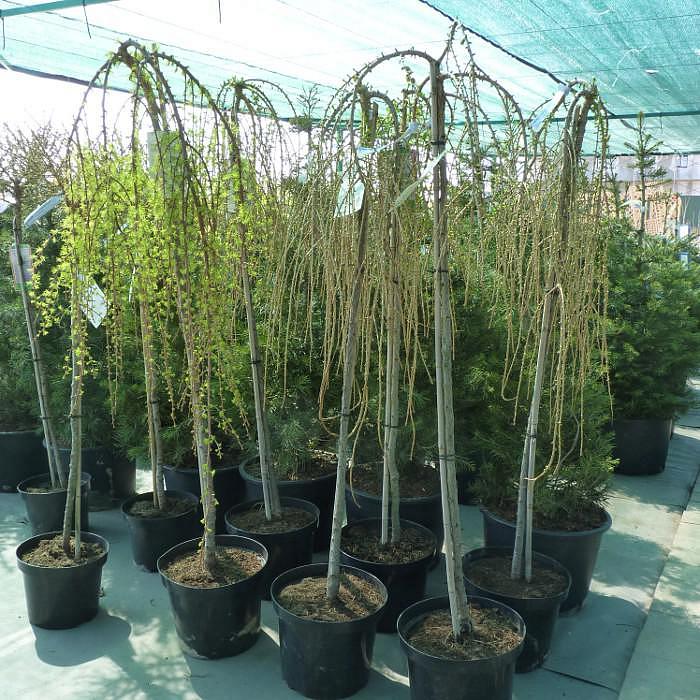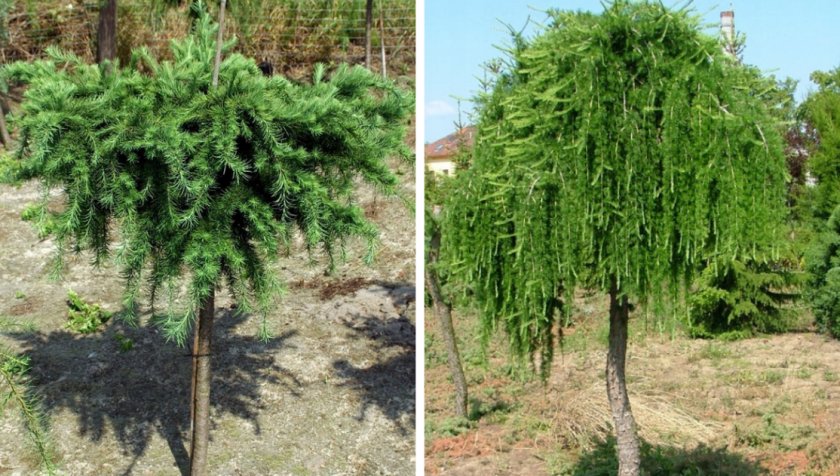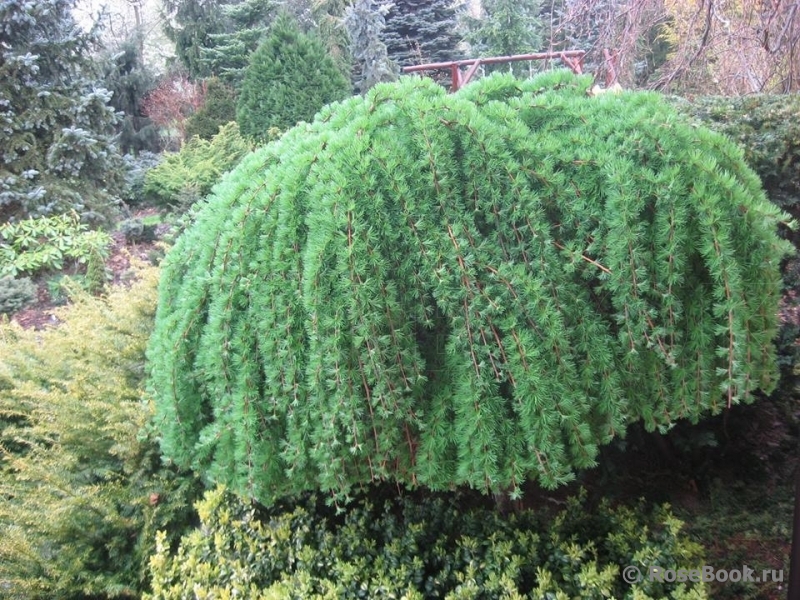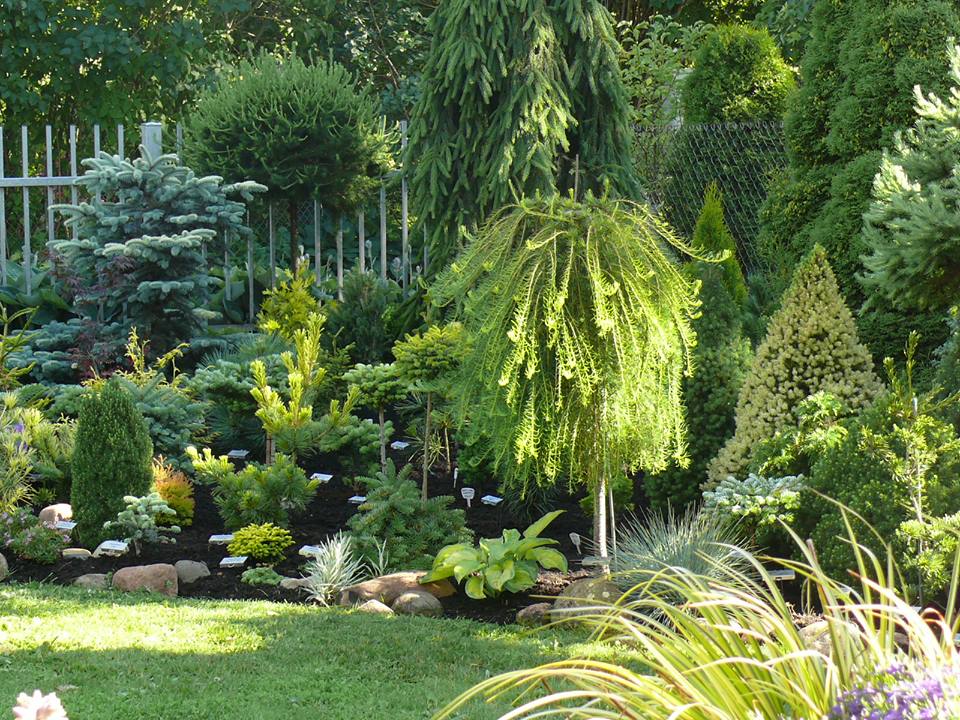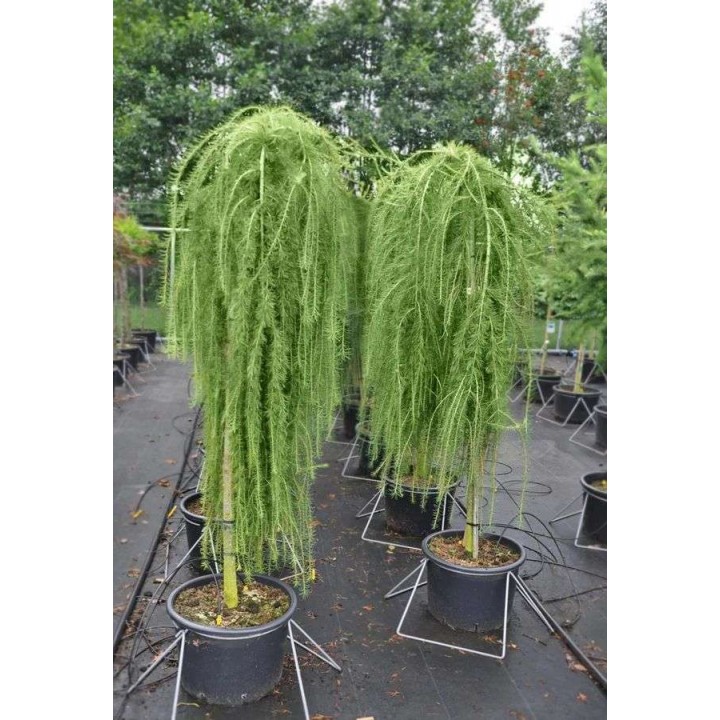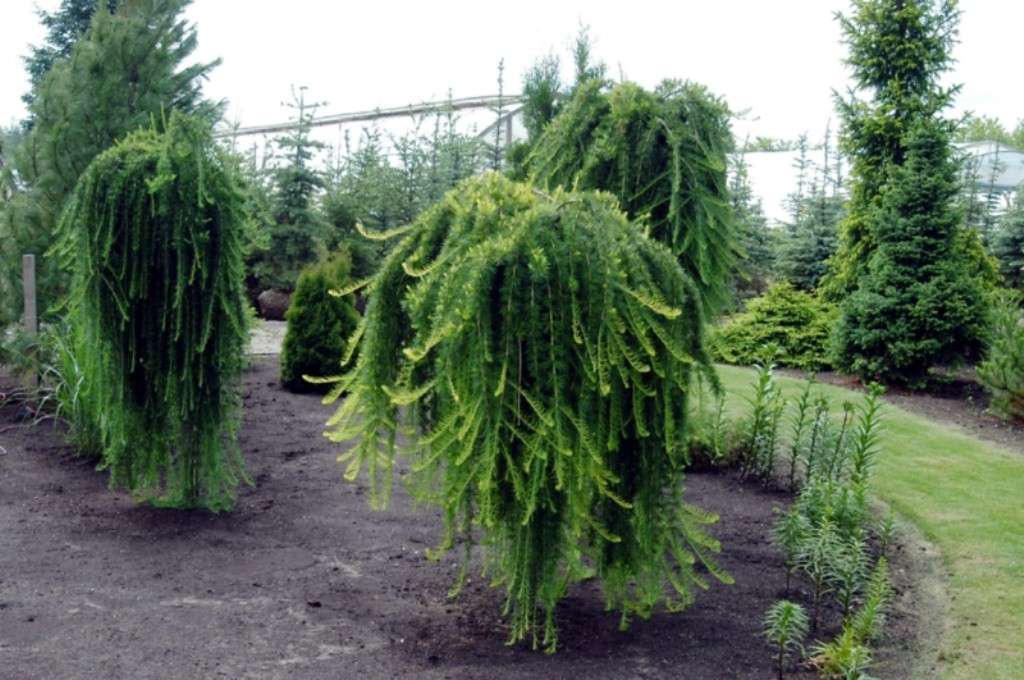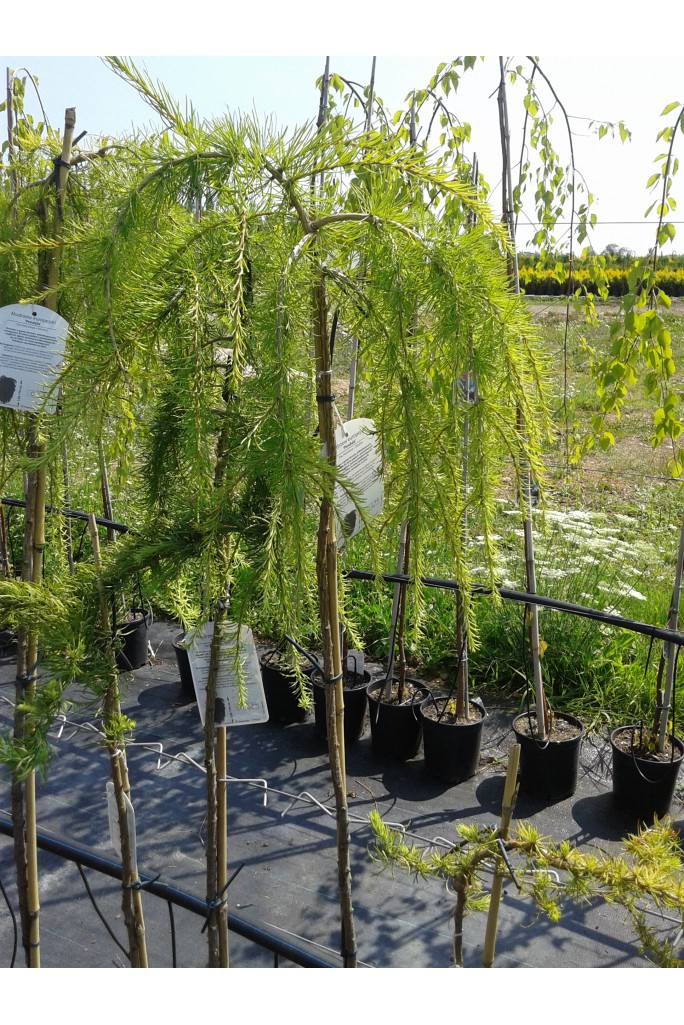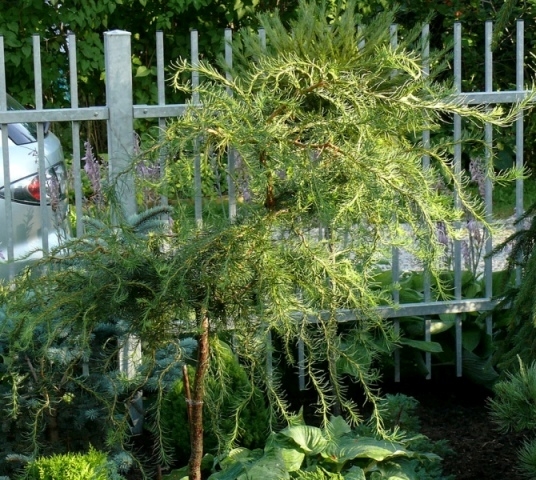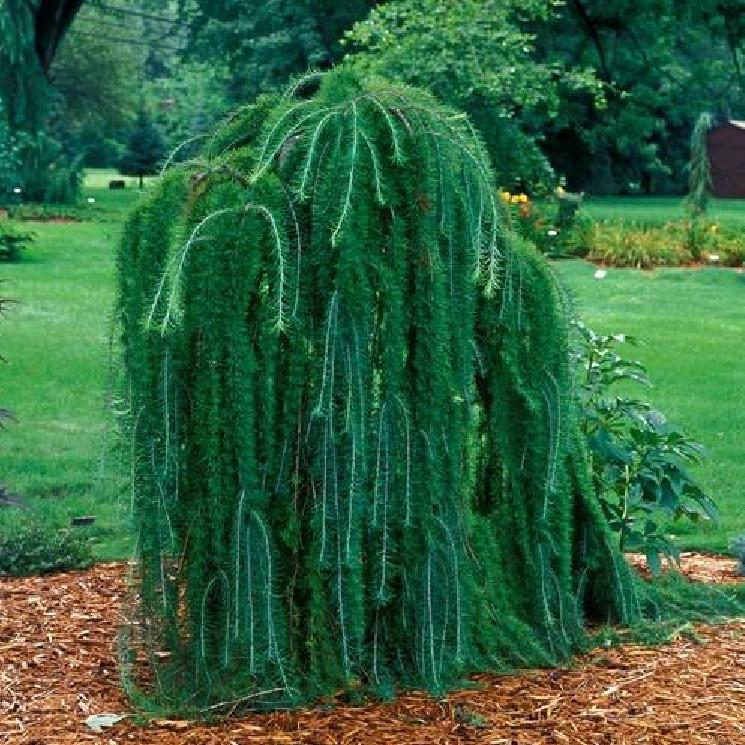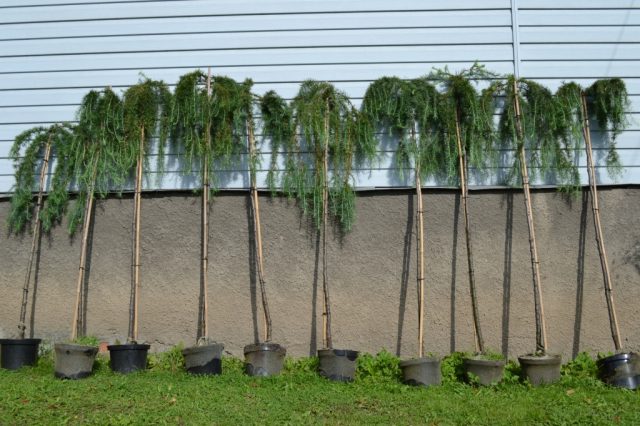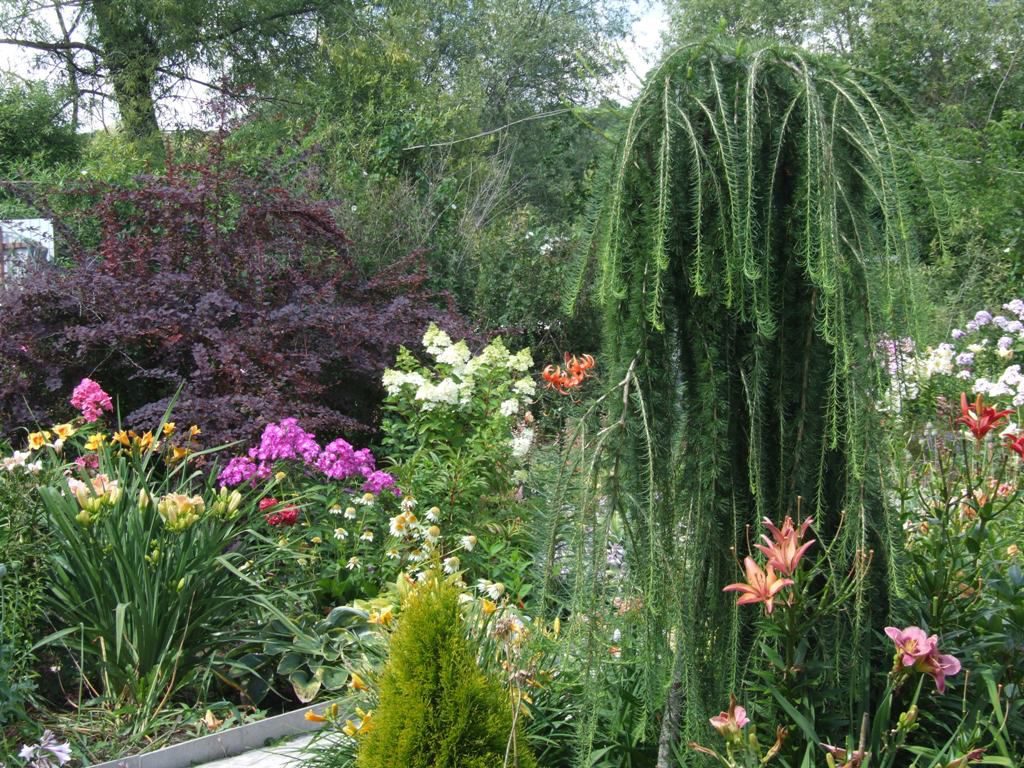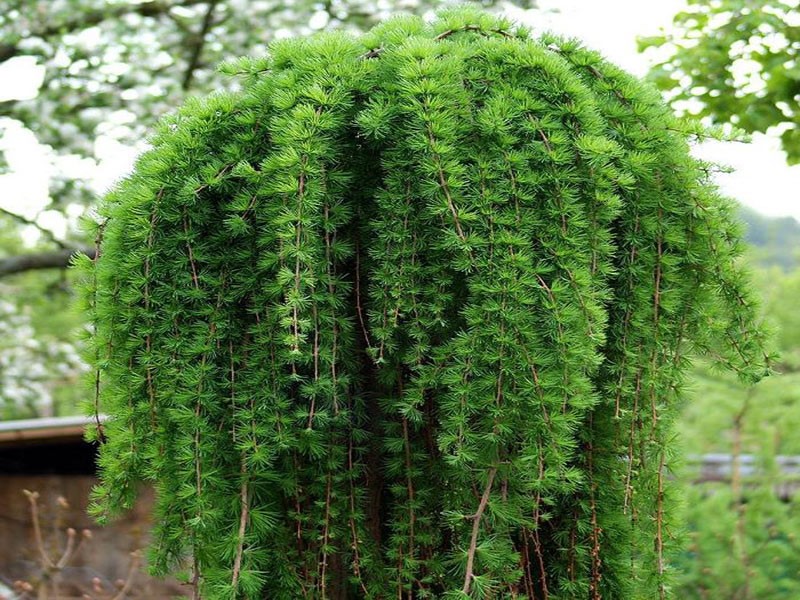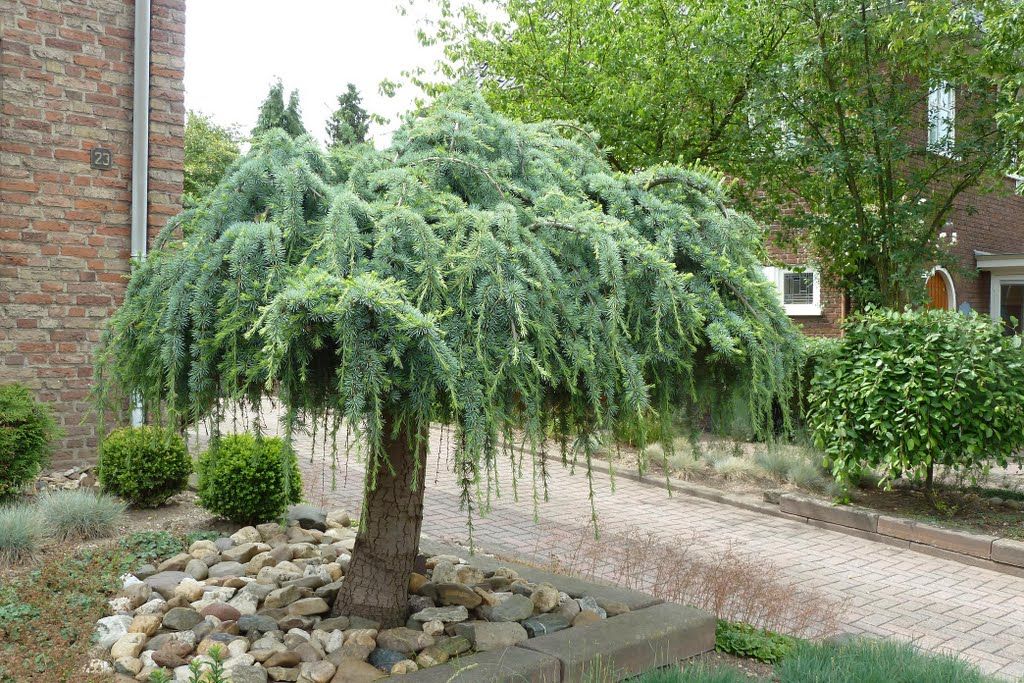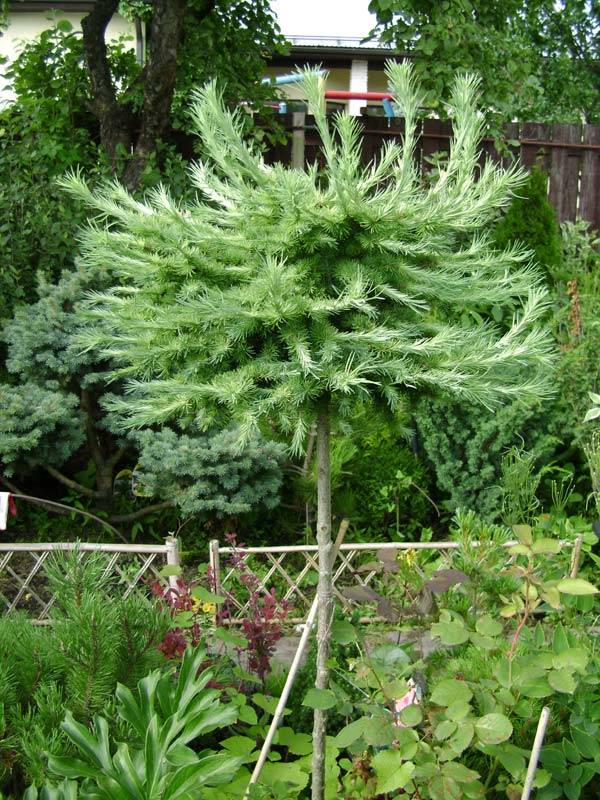Planting and caring for larch on a trunk
Larch is an unpretentious plant. Acquiring a standard form, they carry out preparatory work on the site. An ornamental tree is planted in early spring, before the buds bloom. In autumn, planting is carried out before the beginning of leaf fall, in the first half of the season.
Seedling and planting plot preparation
For planting larch on a trunk, a sunny place or partial shade is suitable. Choose an area with light, drained soil. In conditions with heavy acidic soil, drainage and liming are required. On sandy soil, the tree feels bad and may die. Excessive moisture is undesirable for larch. When planting a certain type of tree, the natural conditions of its habitat are taken into account.
Saplings no more than 2 years old are used. They are sold in containers with a closed root system. When planting, it remains to remove the seedling from the container, place it in the prepared planting site.
Landing rules
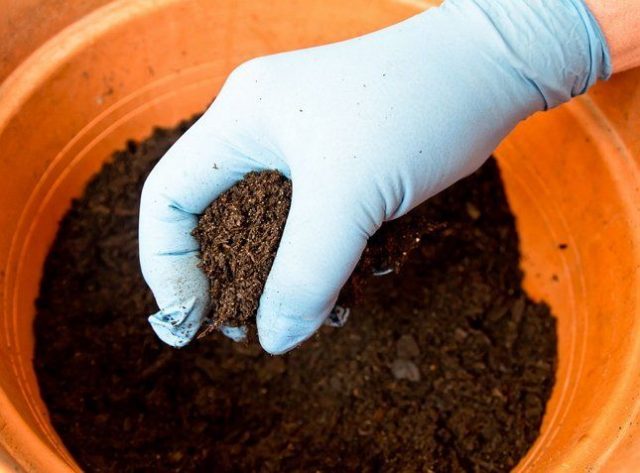
When landing, adhere to the rules:
- A hole is prepared for planting a stem. Its dimensions make it 2 times larger than an earthen coma.
- Peat, humus or compost are added to the soil removed from the planting pit. For 1 part of the soil, take 1 part of peat and 2 parts of humus. In the presence of a large amount of clay, sand is added.
- A little prepared soil is poured into the pit, the root system is placed along with a lump of earth.
- Fill a hole with a seedling with a prepared soil mixture, tamp the surface. Watering.
- The root system is buried 80 cm.
- When planting several plants, the distance between the boles is made up to 2-3 m.
Further care of the larch on the trunk is not difficult.
Watering and feeding
The seedling needs regular moisture. In dry weather, larch needs up to 2 buckets of water 2 times a week. There is no need to water during the rains. Seasonal rainfall is sufficient for adult plants.
Larch growth is activated after the application of potash and phosphorus fertilizers. The tree responds well to compost. Top dressing is done in the first years of growth. Nutrient mixtures are applied in the spring. It is recommended to use a special composition of "Kemir". In June, fertilizing with urea is carried out. Use 10 g per bucket of water. The stores sell special fertilizers for conifers.
Mulching and loosening
The trunk circle is mulched after planting and watering. This protects the soil from moisture loss. Pine bark, peat, humus are used for these purposes. When using humus, mulching and feeding are combined.
The soil around the larch seedling is weeded. Prevents sod formation. The soil is loosened. Shallow loosening is carried out within 2 years - up to 20 cm.
Trimming and shaping
Caring for weeping larch involves annual pruning and crown formation. There are 3 types of pruning:
- Forming. Pruning is carried out in the spring. Remove unnecessary branches, prune growth points. As a result, the tree becomes bushier. Such pruning is necessary for young plants.
- Anti-aging. Pruning is carried out in the spring or early autumn. All weak shoots are removed. Mature branches are shortened by a third. Young shoots will appear on them.
- Sanitary. Trim as needed. The reason is the damage to the tree by pests and diseases. Remove dried branches.
Larch does not lend itself to forming. Cropping in order to get a shape will not work. Weeping larch shoots are thinned out so that the sun penetrates to each shoot. Thin ones are removed, the rest are cut to half.
Preparing for winter
Young larch is prepared for winter. They make a fence, cover with non-woven or other material. Pre-remove dried branches.
How to grow larch from seeds
In nature, larch reproduces with the help of flake seeds. Before sowing, the planting material, which is carried out at the end of April, must undergo cold stratification for 30-40 days.
The seeds are soaked in water for 24 hours, then mixed with a small amount of wet sand or vermiculite, placed in a bag and left in the refrigerator at a temperature of 3-5 ° C.
After the required time has elapsed, the seeds are removed from the refrigerator and sown in open ground in a mixture of peat and sand (3: 1) to a depth of about one and a half cm. Watered with a spray.
Seedlings
The soil should be moderately moist, but not wet. At the end of summer, seedlings must be thinned out. For the winter they cover with spruce branches. After 2 years in early spring, young seedlings can be transplanted to a permanent place.
The transplant is carried out with a part of the earthen coma so as not to damage the roots. For the next 2-3 years, plants need insulation in winter.
Diseases and pests
Larch needles fall off or larch turns yellow. Various factors lead to the problem.
Spruce-larch green hermes (Adelges laricis) is an aphid that feeds on spruce and larch sap. Causes damage to needles that turn yellow and fall off prematurely. During the larval phase, the pests hibernate on the tree.
Aphid defeat
In the spring, after reaching puberty, females lay eggs, giving rise to the next generation. The larvae feed on young shoots, causing their deformation.
On the threshold of spring and summer, winged forms migrate, while the rest still feed on needles. Hermes females are noticeable as they are covered with a white matter, similar to fibrous flakes.
Signs of aphid infestation
Pests are dangerous for young and weakened trees
It is also important to avoid planting larch near natural spruce trees. To combat hibernating larvae, a preparation based on paraffin oil should be used.
Another pest is the moth (Carchophora laricella), which lays the larvae in needles. The pest causes yellowing of the needles, weakens the tree, and restricts the growth of shoots. Moles are killed with a systemic insecticide
Schütte is a group of fungal diseases. It is characterized by the appearance of yellow spots or stripes on the needles, which subsequently become reddish brown and fall off.
Fungal disease
The development of the disease is favored by high humidity, manifests itself suddenly in rainy weather. The affected shoots are removed and burned, the plant is repeatedly treated with an appropriate fungicide.
Larch also turns yellow due to a lack of moisture in the soil or a lack of sunlight.
Dwarf varieties and larch on a trunk in landscape design
Larch on a trunk is an amazingly beautiful coniferous tree, which looks most impressively as a tree in rockeries, on small lawns or flower beds with ground covers and in a variety of compositions with other representatives of conifers and shrubs.
Low specimens are planted near the entrance to the house or garden. Large tapeworms are the focal point of any landscape. In landscape design, this form is used to create oriental garden styles.
Low-growing forms will look great surrounded by heathers, dwarf pine or spruce, creeping golden junipers, ornamental-leafy shrubs. This combination maximizes the beauty of miniature varieties.
How to plant?
As you know, planting largely determines the future growth and development of any plant.
In order for the larch planted by you to meet all your hopes, it is important to carefully consider the choice of the planting site. So, the site should be sunny or in partial shade.
As for the soil mass, it must be light and drained without fail. If you do not have a lot of choice regarding the soil, and you only have acidic soil at your disposal, then it is important to carry out the necessary drainage and liming procedures before planting.
It is worth noting that it is not recommended to plant larch in sandy soil, since the plant is very likely to die.
For planting, it is allowed to use only those seedlings whose age does not reach two years. Typically, such specimens are sold in containers, while their root system is in a closed state.
Among other things, in order for the landing to be successful, several mandatory rules must be followed.
First of all, you need to prepare a suitable hole in size. Its dimensions should be 2 times larger than the earthen clod of the seedling that you purchased.
It is necessary to prepare a suitable soil mixture: it should consist of soil, peat, humus or compost (in this case, it is necessary to observe the proportions of 1 to 1 to 2)
It is worth paying attention to the fact that if the soil is clay, then it is recommended to add a small amount of sand to the soil mixture.
After all the preparatory work has been carried out, the seedling is placed in the hole, covered with soil mixture, and then the surface is tamped on top and watered.
Important! The depth of the hole should be at least 80 centimeters, and if you are planting several plants at once, then there should be a distance of at least 2 meters between them. Only in such conditions will larch be able to actively grow and develop.
Description of standard weeping larch
Standard larch is formed in the process of pruning, cutting shoots. The second way of formation is special vaccinations. The result is a plant with a straight tree trunk and a mass of downward-facing branches. Standard larch grows from 1 to 8 m. The sizes depend on the place of grafting. After it, the stem increases in size by 10 or 20 cm. Annually, the diameter of the crown will increase by 20 cm, the height - by 30 cm. The width of the stem reaches 1.5 m.
In spring, larch forms bunches of needles on the shoots. Soft needles have different shades of green. It depends on the type of trunk. Shoots are thin, uneven. There are many tubercles, processes on them. In adulthood, male and female bumps form. Women are especially beautiful. They are painted in bright colors, like miniature roses. In the fall, the needles turn yellow and fall off.
Botanical description and places of growth of larch
Larch is a genus of woody and coniferous trees belonging to the Pine family. It differs from its evergreen counterparts in that its needles fall off every year before the onset of winter.
In the wild, the trunk grows up to 50 m in height if the specimen is in comfortable conditions. The diameter of its trunk reaches up to 1–1.5 m. But in garden culture, plants with smaller dimensions are used. The tree can be called a long-liver, because it lives up to 3-4 centuries. Its branches are decorated with soft green needles falling in autumn. The needles are collected in bunches of 20-50 pieces.
It grows in the Northern Hemisphere in Russia (mainly from the Urals to the Kuriles), North America and Europe. In the Old World, most of the trees are concentrated in the Alps and Carpathians. As an ornamental crop, it is found all over the world, where climatic conditions allow it to grow.
Rules for planting and caring for larch on a trunk
Planting and caring for larch on a trunk is not laborious. If you strictly follow the rules of cultivation, a beautiful plant will decorate a flowerbed even for an amateur gardener.
Recommended timing
When planting a crop, it is important to consider the timing.According to experienced summer residents, early spring and early September are considered the most favorable time for planting larch in open ground.
Important! If you plant a seedling in a hot time, then, most likely, it will die or it will be poorly accepted and hurt.
Site selection and soil preparation
Particular attention should be paid to the location during planting. It should be well lit by the sun or in partial shade
The tree does not like transplanting, therefore, it is necessary to determine the site immediately, so that later it does not have to be changed.
Weeping larch on a trunk prefers light soil with good drainage, but perceives sandy soil and marshland poorly.
It is necessary to select a site remote from the flow of groundwater
Landing algorithm
You need to plant a culture according to the following scheme:
- Dig a hole up to 70 cm in diameter, up to 90 cm deep.
- Make drainage.
- Add a mixture of soil, dolomite flour and humus.
- Drizzle with two buckets of water.
- Place the seedling in the hole along with a lump of earth and a support so that its root collar is above ground level.
- Fill the planting hole with soil, tamp.
- Spread the mulch over the surface in a layer of 5 cm (peat, tree bark or sawdust is suitable).
There is no need to water the plant after planting.
How to grow larch on a trunk
Getting a beautiful tree in your garden is not difficult. If you follow all the rules of cultivation, then the result will certainly delight the gardener. Caring for weeping larch consists of carrying out the usual procedures: watering, fertilizing, loosening, pruning and preparing for the winter.
Comment! The older the representative of the culture, the less she needs care.
Watering and feeding schedule
While the weeping larch seedlings are young, they need regular moisture. If the summer turned out to be dry, then two buckets of water should be consumed for each instance 2 times a week. If the season is rainy, with frequent precipitation, then additional moisture is not necessary. An adult plant need not be watered at all, natural moisture will be enough for it.
As for fertilization, for active growth of larch on a trunk, fertilizing based on phosphorus and potassium is necessary, sometimes it is good to make compost. Fertilizing the crop should be at the initial stage of growth and in the spring. Feeding with urea is allowed in June.
Mulching and loosening
At the stage of planting the plant, to retain moisture, it is recommended to lay a layer of mulch under it. In addition, the surrounding soil should be regularly loosened and free of weeds. The first couple of years, the procedure is carried out to a depth of 20 cm.
Important! In the area where weeping larch grows, sod formation should be avoided
Formation of the crown of weeping larch on a trunk
It is possible to form a stem by cutting the plant. To do this, it is recommended to choose a central shoot and remove excess branches from it for several years. The crown is created by pinching the tops of the shoots.
In spring and autumn, weeping larch needs sanitary pruning, when weak, diseased, dried branches are removed from the tree and adult branches are cut by 1/3.
The stem, if necessary, is allowed to be tied to the support
Preparing for winter
Adult conifers do not need preparation for frost, they can easily tolerate low temperatures and do not freeze. But young trees are recommended to be covered with non-woven materials for the winter. In addition, in late autumn, it is advisable to remove all dried branches from the larch.
Diseases and pests
Due to waterlogging, larch can be attacked by Schütte fungi. Signs of the disease: loss of needles, the appearance of yellowish and brown spots. Infected shoots must be cut and burned, and the tree must be sprayed with fungicides. For prevention, proper care and treatment with medicinal preparations is necessary.
Common pests are aphids and spruce moths.Both cases are characterized by yellowing and falling of the needles (in summer). At the first sign, the tree is treated with a solution of laundry soap or paraffin oil products. If insects are not removed, it is necessary to resort to insecticides.
Pendula in garden design
 In 1836, the European pendula larch was discovered by scientists. From that moment on, European gardeners began to actively use it in their works due to the decorative appearance. She is good in both group and single landings. The trees obtained by the grafting method are not tall. Their growth usually does not exceed the height of the trunk and is approximately one and a half meters. The tree is one meter wide. The crown has excellent twisting branches, with insignificant lateral branches. The color of the needles is green with a bluish tint. In the fall, the needles crumble. The cones are colorful, the male ones are golden, the female ones are red.
In 1836, the European pendula larch was discovered by scientists. From that moment on, European gardeners began to actively use it in their works due to the decorative appearance. She is good in both group and single landings. The trees obtained by the grafting method are not tall. Their growth usually does not exceed the height of the trunk and is approximately one and a half meters. The tree is one meter wide. The crown has excellent twisting branches, with insignificant lateral branches. The color of the needles is green with a bluish tint. In the fall, the needles crumble. The cones are colorful, the male ones are golden, the female ones are red.
Pendula is extraordinarily beautiful, has a delicious coniferous aroma, soft and delicate needles. Looks great even in the absence of needles in the winter. Since the shape of the branches, covered with short shoots and tubercles, with small variegated cones, creates an original "lace" that decorates the snow-covered garden in its own way.
Pendula is photophilous and withstands winter cold well. Prefers alkaline moist and fertile areas. When planting, you must carefully close the planting pit. Sultry summers require generous watering.
Every spring, in the first four years after planting a tree in the ground, it is required to prune annual growths in order to grow a lush crown. To obtain a multi-tiered tree, fresh shoots should be tied to a vertical support for three years.
Standard larch pendula is universal in design, since the color of its even bluish-green needles can become a background for creating catchy compositions. The tree goes well with groups of other types of trees, including deciduous trees, shrubs and other ornamental garden plants. It looks great on lawns and in the vicinity of bright flower beds.
Pendula is resistant to air polluted by industrial emissions and vehicles, so it can be used as a plant that protects the ecological well-being of the urban environment.
Graceful decoration of the landscape - larch: planting and caring for the plant
To create a unique beauty in a summer cottage, designers advise using conifers. They have a special appeal and charm throughout the season. Despite the fact that the Siberian beauty loses needles for the winter, she is truly a majestic tree.
Consider the secrets of the care and planting of larch in the Moscow region, since here it is very popular. They consist in the following main aspects:
- landing time;
- the nature of the soil;
- lighting;
- humidity;
- pruning.
Fulfilling these simple requirements consistently, an amazing coniferous plant with soft needles will appear near the house. Unfortunately, some believe that the tree is of little use. Therefore, a controversial question arises: is it worth growing larch in the country? Pros and cons - different opinions, but the decision is best made individually, after a close acquaintance with the culture.
Planting timing
First of all, you need to find the perfect time for planting. The best option for performing the procedure is spring before the needles appear, or mid-autumn, when the first falling of the needles began. During this period, the soil contains a small number of microorganisms that can disrupt the root system of larch. Its main feature is mycorrhiza, which lies in the natural symbiosis of roots with fungi. As a result, the tree successfully assimilates minerals and other nutrients from the soil. A plant is planted along with an earthen lump, regardless of its age.
Suitable substrate
The unpretentious northern beauty grows wonderfully on various types of soil:
- acidic;
- neutral;
- alkaline.
An example of this is the natural environment in which larch occurs: mountain slopes and wetlands.
Despite this, it is important to understand that bred varieties are more vulnerable to growing conditions than natural varieties. Planting larch in autumn or spring is carried out in the usual way.
For this, a wide hole is dug, which is 2 times the rhizome of the culture. Then the soil is mixed with peat and humus. Clay soil is diluted with coarse river sand. The bottom of the pit is covered with the prepared substrate, the seedling is laid and covered with the remaining soil. The upper ball is carefully tamped and watered with clean water.
Adequate amount of light
In order to enjoy watching how the larch grows, it is important to choose a suitable site for it. Most varieties prefer an abundance of sunlight.
If you plant a tree in partial shade, it starts to hurt and its growth slows down. In some cases, larch dies altogether. With a lack of lighting, the number of shoots decreases. Therefore, the tree cannot form a pyramidal crown, and in the summer it looks almost naked and unattractive.
Wise approach to soil moisture
Young larch seedlings actively develop in moist soil. Therefore, during dry periods, it needs regular watering. Mature plants do without additional moisture, as they can perfectly tolerate extreme climatic conditions. Standard varieties require special care, since they do not like excess and lack of moisture.
Timely pruning of a coniferous beauty
To form a stylish and compact crown, a planned pruning of larch is carried out in early spring until the buds appear. The young branches of the plant are shortened by about 2 buds. Some types of larch are used as hedges. They need regular formative pruning. The drooping branches of Pendula larch are thinned out once every 3 or 4 years, removing half of their length. As a result, the plant receives an abundance of air and sunlight.
Diseases and pests
The culture is distinguished by high immunity to diseases and insects, but for prevention it is customary to periodically process it with a solution of copper sulfate. These problems do not always bypass the larch side, especially if the young specimen is not provided with proper care. If the needles turn yellow and fly around in the summer, then we can assume that the tree has become a victim of aphids. The larvae of this insect love to winter on the plant, and from spring the females lay eggs. Paraffin oil is considered an effective means of combating this pest. Another frequent uninvited guest of larch is the moth. The attack of this insect can be judged by the slow development of shoots, yellow needles, and falling needles. Insecticides will help get rid of the insect.

Copper sulfate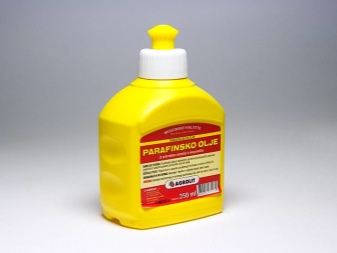
Paraffin oil
Of the diseases, the culture is most often affected by the Schütte fungus. This ailment develops under conditions of high humidity. Its presence is indicated by yellow and brown spots, gradually the plant withers.

Larch care and cultivation
Larch does not require too much care when growing. In principle, like most other plants, it must be watered regularly, loosened the soil in the near-trunk circle, get rid of nearby weeds, feed them with nutrients and, if necessary, cut them off.
Watering, weeding and loosening the soil
Larch has such a feature as drought intolerance. Therefore, watering of young plants (up to two years old), as well as adult specimens, should be mandatory during dry periods. Approximate water consumption is 20 liters per mature tree once or twice a week.
Did you know? Larch is advised to be watered with water that was used to wash the mushrooms.
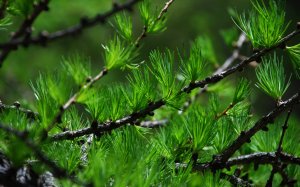
As for loosening and weeding, only young growth requires this. Mature plants can easily do without this procedure.
To give attractiveness to some types of coniferous beauty, its branches can be cut off, giving interesting shapes to the crowns (openwork hedges, crown balls, etc.) and restraining growth. Only young larches are subject to pruning.
Fertilization
In the first year after planting, in May, a young plant can be fertilized with a complex fertilizer - “Kemira Universal” (20 g / 1 sq. M) or dressings containing potassium and magnesium will do. At the beginning of summer, to improve the decorative qualities of the needles, the crown is watered with a watering can with a solution of urea (10 g / 10 l of water).
In the future, you can annually in early spring, before the start of shoot growth, fertilize conifers.
Soil mulching
The soil is mulched with a layer of 5-6 cm immediately after planting, using straw, peat, sawdust, needles.
Larch tolerates even the most severe winters very well and does not require additional measures to prepare for the cold. However, young plants, especially on a trunk, are best wrapped in burlap. Some species will also need a garter to keep the branches from breaking off under the weight of the snow.
How to take care of it properly?
Caring for the presented culture is not difficult and includes several stages.
Watering. Regularly, a young specimen needs hydration. In dry times, the volume of water for one sample is 2 buckets twice a week. With heavy and frequent precipitation, the tree does not need watering. Adult conifers do not need to be watered, they have enough natural moisture from precipitation.
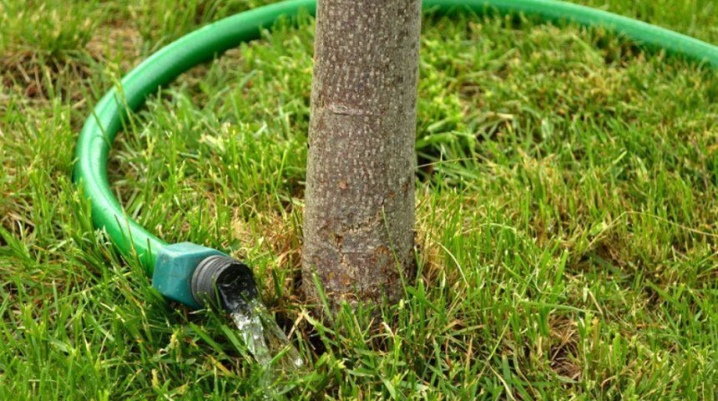
Top dressing. For active growth, the crop needs fertilizers based on potassium and phosphorus. The plant also responds well to compost. Additional nutrition is introduced in the first years of the tree's life in the spring - during this period, the "Kemira" remedy is suitable. In June, it is advisable to feed the culture with urea in a proportion of 10 g per bucket of water. And it is also allowed to use formulations intended for feeding conifers.

Mulching and loosening. The layer of mulch laid out during the planting phase helps to retain moisture inside. It is also recommended to periodically weed and loosen the soil. In the first two years of life, loosening is carried out to a depth of no more than 20 cm. Try not to allow sod formation.
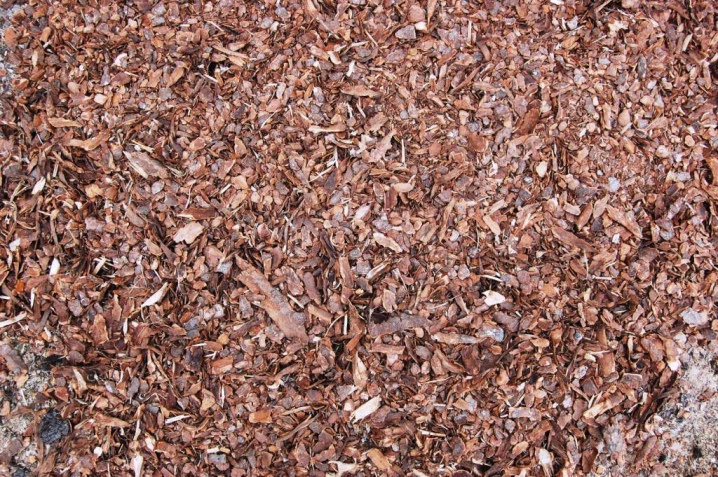
Trimming and shaping. The stem is formed by decorative trimming. To do this, a central shoot is selected from the tree, all unnecessary branches are removed over several years, during which time the desired shape will be formed. If necessary, the stem is tied to the support. The crown is created by pinching the top of the shoots. In addition to decorative haircuts, larch needs rejuvenating and sanitary pruning. The first is carried out in spring or early autumn. In the course of rejuvenating pruning, all weak branches are eliminated, and adult branches are cut by 1/3 so that new shoots appear on them. Sanitary cutting involves the removal of dried, damaged, sick, frozen branches.
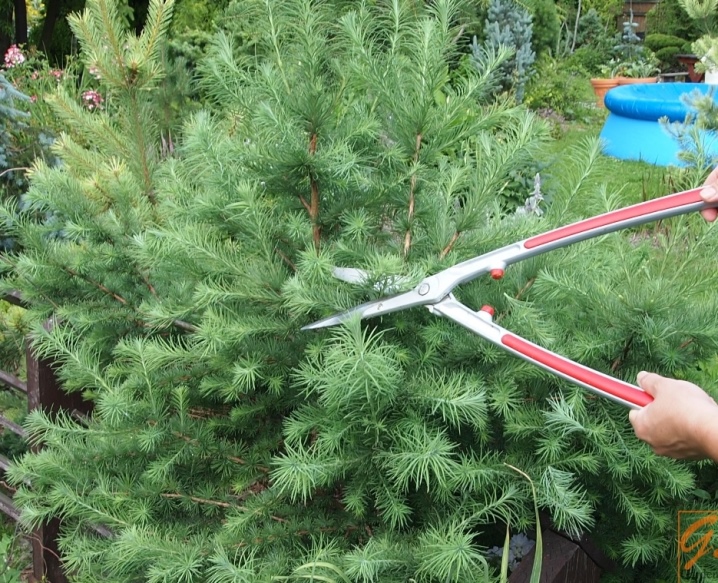
Preparing for winter. Before wintering, in a young specimen, all dried branches are removed by the pruning presented above. To prevent the tree from freezing, a cover made of non-woven material is prepared for it. You can equip a fence for the winter. Mature trees do not need insulation - they tolerate frost well on their own.
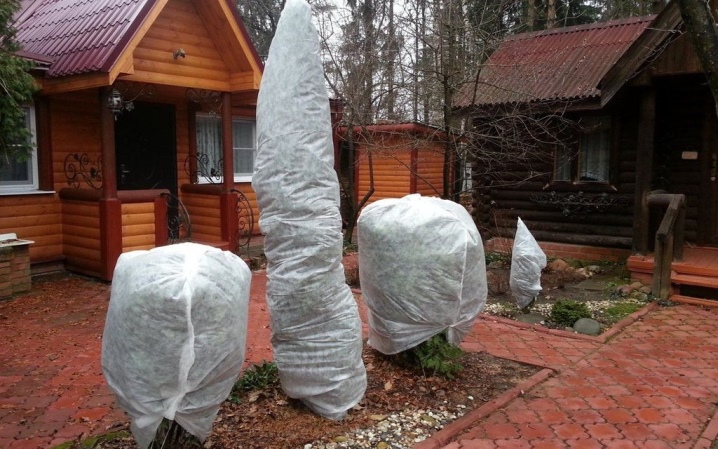
Use in landscape design
Stamp forms are suitable for decorating a garden in any style. They can decorate alpine slides, gazebos, flower beds, the entrance to the house. You can grow trees around the edges of the gate or make a hedge. Both single and collective landings are possible.

The stems harmonize beautifully with various decorative cultures. So, weeping varieties of standard forms are popular. They are great for decorating a small area.If this is the Pendula variety, then herbaceous plants will look aesthetically pleasing at its foot. Low-growing species create picturesque landscapes when combined with juniper, spruce, linden, ash, oak, rhododendron.
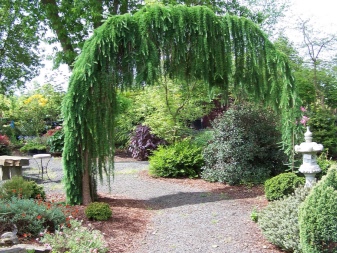
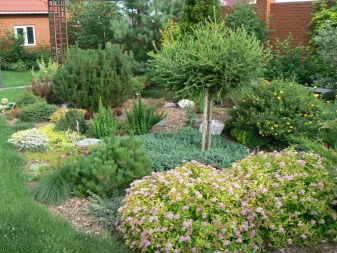
How to cut larch on a trunk, see the next video.
Creating comfort and beauty on your site, do not forget about conifers. They have a special attractive beauty and charm. And if you apply a standard growing form to a tree, then the garden plot will be unusual to the envy and surprise of all neighbors.
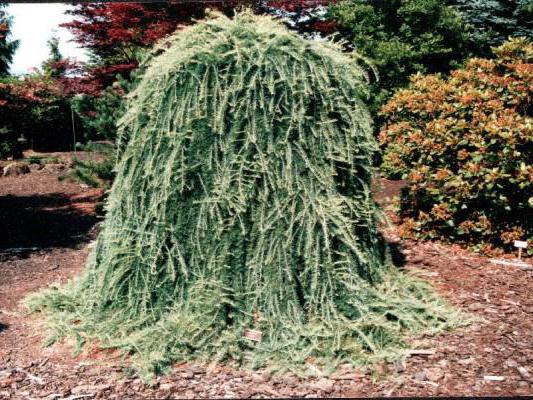
The larch on the trunk is perfection itself. Not everyone has such beauty. So there is an opportunity with the help of such a decorative tree to make your site unique.

